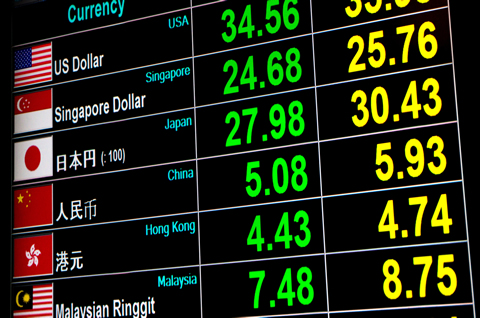
Foreign exchange is the trading of different national currencies or units of account. It is important because the exchange rate, the price of one currency in terms of another, helps to determine a nation’s economic health and hence the well-being of all the people residing in it.
Currency fluctuations create uncertainty and can quickly turn a solid profit into losses. That is why we need a currency strategy.
There are more than 100 different kinds of official currencies in the world. However, most international forex trades and payments are made using the U.S. dollar, British pound, Japanese yen, and the euro. Other popular currency trading instruments include the Australian dollar, Swiss franc, Canadian dollar, and New Zealand dollar.
The Bretton Woods Agreement
The purpose of the Bretton Woods meeting was to set up a new system of rules, regulations, and procedures for the major economies of the world to ensure their economic stability. To do this, Bretton Woods established the International Monetary Fund (IMF) and the World Bank.
The Bretton Woods agreement was created in a 1944 conference of all of the World War II allied nations. It took place in Bretton Woods, New Hampshire. Under the agreement, countries promised that their central banks would maintain fixed exchange rates between their currencies and the dollar.
The Bretton Woods Agreement and System created a collective international currency exchange regime that lasted from the mid-1940s to the early 1970s. The Bretton Woods System required a currency peg to the U.S. dollar which was in turn pegged to the price of gold.
As a result of the Bretton Woods Agreement, the U.S dollar was officially crowned the world’s reserve currency, backed by the world’s largest gold reserves. … Needing a place to store their dollars, countries began buying U.S. Treasury securities, which they considered to be a safe store of money.
Why did the Bretton Woods system collapse?
The US decision to suspend gold convertibility ended a key aspect of the Bretton Woods system. The remaining part of the System, the adjustable peg disappeared by March 1973. A key reason for Bretton Woods’ collapse was the inflationary monetary policy that was inappropriate for the key currency country of the system
The present values of the foreign currencies (last week):
- U.S Dollars: 73.79 Indian Rupees
- British Pounds: 93.77 Indian Rupees
- Japanese Yen: 0.70 Indian Rupees
- Euro: 86.02 Indian Rupees
- Australian Dollar: 51.98 Indian Rupees
- Swiss Franc: 80.00 Indian Rupees
- Canadian Dollar: 55.11
- New Zealand Dollar: 48.24 Rupees
- Chinese Yuan: 10.84 Rupees
- United Arab Emirates Dirham: 20.13 Rupees
- Pound Sterling: 93.90 Rupees
Investment Managers and Hedge Funds
Portfolio managers, pooled funds and hedge funds make up the second-biggest collection of players in the forex market next to banks and central banks. Investment managers trade currencies for large accounts such as pension funds, foundations, and endowments. An investment manager with an international portfolio will have to purchase and sell currencies to trade foreign securities. Investment managers may also make speculative forex trades, while some hedge funds execute speculative currency trades as part of their investment strategies.
Multinational Corporations
Firms engaged in importing and exporting conduct forex transactions to pay for goods and services. Consider the example: Thermax Ltd is India’s leading solar energy companies; Thermax buys German solar panel from a German company which imports American components. Thermax sells the solar energy plant to a Chinese company. Thermax receives Chinese yuan which they must covert in Euro to pay the German manufacturer and the German manufacturer must then exchange euros for dollars to pay the American components company. The fact is that firms trade forex to hedge the risk associated with foreign currency translations. The same German firm might purchase American dollars in the spot market, or enter into a currency swap agreement to obtain dollars in advance of purchasing components from the American company in order to reduce foreign currency exposure risk.
Big Indian organizations such as Tata Motors, Dr Reddy’s, Infosys, ICICI Bank, HDFC Bank, MakeMyTrip etc are listed on New York Stock Exchange (NYSE). Indian companies can raise foreign currency funds through the issue of American Depository Receipts (ADRs) and Global Depository Receipts (GDRs).
These ADRs and GDRs help companies to tap foreign funds and increase their shareholding base which leads to better share valuation and also creates value for shareholders.
However, most companies go for the GDR route since the accounting norms and other disclosures in case of GDR are less stringent than the requirements in the U.S.
Let’s understand them one by one.
American Depository Receipts
American Depository Receipts (ADRs) are a way of trading non-U.S. stocks on the U.S. exchange. Through ADRs, Indian companies who are willing to raise funds from the U.S. can do so by issuing shares on American Stock exchange.
However, the issuance of ADR is governed by the rules and regulations as laid down by the regulator SEC (Securities and Exchange Commission). The Indian Companies will have to maintain accounts as per the American Standards.
The Indian companies cannot directly list their equity shares on the international stock exchange. So in order to overcome this problem; the companies give shares to an American bank. These American banks in return for those shares provide receipts to the Indian companies. The companies raise funds by providing those ADR receipts in American share market.
How are ADRs created?
Indian companies cannot directly list their equity shares on the international stock exchange. In order to overcome this problem the corporation gives shares to an American Bank. These banks will take hold of the stock, and issue receipts to Indian companies in return. The companies raise funds by providing those ADR receipts in American share market. These ADRs are listed on the major stock exchanges of the US, like NASDAQ. They can also be sold Over-The-Counter (OTC).
Trading Mechanism of ADRs
One ADR comprises of a certain number of shares in an Indian company and these ADRs are quoted in US dollars. The investors of a foreign country can buy and sell shares directly and the investor is free to convert the ADR to receive the equivalent number of shares. For example, an American citizen willing to invest in Infosys limited in U.S. can do so by purchasing ADR from the listed entity. As an investor, they will receive all the dividends and capital gains in US dollars, no matter where the original company is from.
Trading Mechanism of GDRs
GDRs act as negotiable certificates. Therefore, they are usually traded just like shares of a company in any international market. A single GDR can represent different amounts of shares, as per the company’s needs and objectives. GDRs can also be used to raise capital from countries in the form of US Dollars or Euros. When GDRs are traded in Euros, they are known as European Depository Receipts or EDRs.
What are the Types of GDRs available to Investors?
There are two broad categories of GDRs –
1. Rule 144A GDRs:
These GDRs are those which operate through the rule 144A of the Securities Exchange Commission (SEC) of the US. This rule allows non-American companies to trade and raise capital in the American Markets. It also makes these GDRs a cheaper alternative to raise capital from American markets than Level III ADRs.
2. Regulation S GDRs:
These GDRs are those which help non-American companies raise funds and establish a trading presence in the European markets only. These GDRs usually trade on the London or Luxembourg Stock Exchange only, and are popularly known as REG S GDRs. Only non-American investors can trade in Reg S GDRs. A company can issue both REG S and Rule 144A GDRs, but they will be subject to different laws.
Differences between ADR and GDR:
- American Depository Receipt (ADR) is a depository receipt which is issued by a US depository bank against a certain number of shares of non-US company stock. Whereas Global Depository Receipt (GDR) is a depository receipt which is issued by the international depository bank, representing foreign company’s stock. ADR is issued in America while GDR can be issued in both America and Europe.
- ADR is listed in American Stock Exchange i.e. New York Stock Exchange (NYSE) whereas GDR is listed in non-US stock exchanges like London Stock Exchange or Luxembourg Stock Exchange.
- ADR can be traded in America only while GDR can be traded in all around the world. ADR Market is more liquid (cash) as compared to GDR market. Liquidity plays a crucial role in financial markets. The improvement and stability of market liquidity is important for market participants and serves as a way to enhance financial market credibility. In the absence of liquidity, financial markets cannot provide accurate price signals to investors and corporations, which are crucial for efficient risk sharing and accurate investment decisions. Without the availability of counter-offers, financial markets cease to exist, and they are replaced by individualized bilateral contracts. Thus, some liquidity is necessary for the very existence of a financial market.
- Investor’s participation is more in ADR as compared to GDR.
- ADR market is a retail investor market whereas GDR’s market is institutional one.
- ADR’s disclosure agreements are more tedious as compared to GDR.
Pros and Cons of ADRs and GDRs:
Depository receipts are a unique way of raising funds for companies and a unique investment for diversified portfolios. However, before we invest in them, we should consider the pros and cons of using ADRs and GDRs for both investors and the issuing companies.
Pros:
- They provide access to investments in the foreign markets, thus becoming a great way to diversify our portfolio.
- They are denominated in US Dollars and Euros, both of which are very powerful currencies to hold investments in.
- Since they are treated like shares, they can easily be traded in markets. They also offer all shareholder benefits to different investors.
- For companies, depository receipts are a great way to attract positive international attention and expand their base of shareholders as well.
Cons:
- Depository receipts are one of the most expensive ways to raise capital for companies.
- Since all transactions are happening in foreign currencies, the investments and capital are subject to the volatility of the foreign exchange or forex market.
- Depository receipts are only suitable for High Net Individuals as high amounts of capital are needed to trade in them.
- There are a limited number of companies which offer their shares in the form of depository receipts, thus leaving lesser choices for interested investors.
- So if you are planning to invest in a foreign company, you can do so through depository receipts.













































